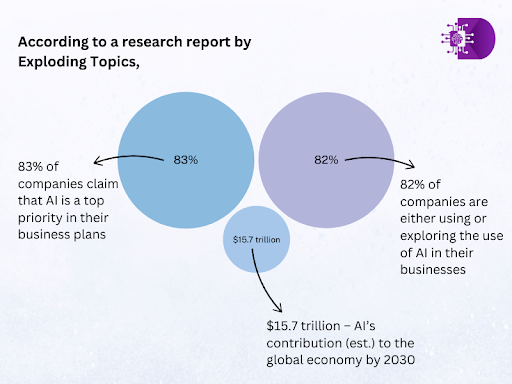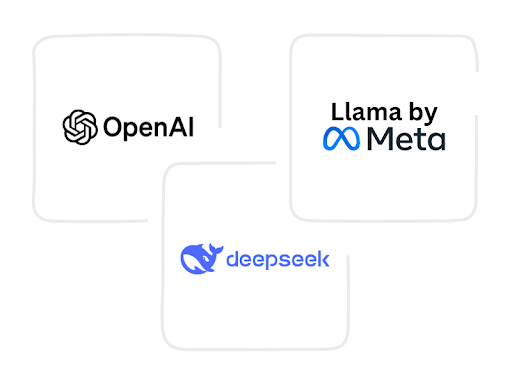Until a few years ago, Artificial Intelligence (AI) was touted as a tech for the distant future. However, that’s no longer the case in 2025. AI has rapidly grown to be a reality shaping in how businesses operate, how researchers innovate, and how people interact with technology. Every day, people are constantly searching for powerful and cost-effective AI solutions that can drive innovation and redefine their workflows.
Worldwide AI Adoption (A Few Stats)

With AI speeding at an unprecedented pace, the emergence of open source and proprietary AI-powered Large Language Models (LLMs) like DeepSeek, OpenAI, Llama and Gemini have opened up infinite possibilities, each bringing their own set of strengths (and weaknesses) to the table. Choosing the right model starts with understanding their unique strengths, practical applications, and what it takes to make them work effectively.
This post will break down the three popular LLMs, OpenAI, Llama and DeepSeek, by exploring their strengths, weaknesses and best case applications. These tools are not just symbols of technological advancement; they are about tackling real-world challenges and driving meaningful progress. Regardless of whether your requirement is for coding, enterprise automation or large-scale data retrieval, this guide will help you make an informed decision.
The Big Three – A Quick Overview of AI Models

- OpenAI
OpenAI, the creator of ChatGPT, is the industry standard for AI models. Its GPT series (with GPT-4 being the pioneer) has transformed industries, with its highly trained models offering unprecedented performance and versatility, excelling in creative and analytical tasks. OpenAI’s models are widely adopted by businesses for tasks like customer support, content generation, and general automation.
- DeepSeek
DeepSeek has exploded on the scene 2025, turning heads with its efficiency at a bargain, compared with its much bigger competitors. With a focus on high-quality NLP (Natural Language Processing) and enterprise-grade solutions, it’s gaining traction among businesses looking for deep customizable AI models that don’t break the bank.
- Llama
Llama, developed by Meta (formerly Facebook), is designed to be an open-source alternative to proprietary AI models. Not the flashiest of all AI models, it has rapidly grown to be a favorite among a niche category – researchers and AI developers. It’s best suited for those businesses that want to exercise a fair control over their AI implementation, minus any heavy licensing costs.
Performance Analysis: Strengths, Weaknesses & Best Use Cases
OpenAI – The AI Behemoth
OpenAI’s GPT models, especially GPT-4, is the gold standard in commercial AI, setting the bar high for parameters like generating human-like conversational texts, complex reasoning, and high-precision NLP applications. It has also been fine-tuned with Reinforcement Learning from Human Feedback (RLHF) which improves accuracy and alignment, making it not just powerful but also more reliable.
Strengths:
- Scalability: Consists of over 1.76 trillion parameters, with speculation that the actual size is even larger.
- Enterprise Capability: Performs well in content creation, coding, and research with industry leading NLP & conversational AI.
- Multimodal Capabilities: Works with text and images, making it useful for creative and analytical tasks.
Weaknesses:
- Pricing: Costs scale significantly based on usage, which means it is on the higher side when compared to competitors.
- Adaptability: Limited customization options for businesses that need tailored solutions.
- Technicality: OpenAI’s models require API integration, which not only adds technical complexities but also, additional expenses.
Best Use Cases:
- Large enterprises looking for state-of-the-art AI capabilities.
- Businesses looking for intelligent AI-driven automation.
- Companies/professionals focusing on content creation, customer engagement, and data analysis.
DeepSeek – The Rising Powerhouse
Amidst the competitive and crowded AI landscape, DeepSeek is rapidly carving out its own space in the market. Built for both businesses and developers, it is designed to balance performance and accessibility, making it easier to be integrated into existing systems without going through any computational processes, thereby earning a reputation as a developer-friendly and versatile model.
Strengths:
- Balanced Performance: Delivers strong general-purpose intelligence while remaining efficient in terms of performance and cost.
- Customizable: Being that it is an open-source model, businesses have the flexibility to fine-tune it for their needs.
- Versatile: Its models are adaptable for both business and AI-driven applications – finance, healthcare, or marketing, DeepSeek can be molded to fit.
Weaknesses:
- Less Adoption: It is not as widely adopted as OpenAI, owing to its lack of pre-built integrations.
- Technical Prowess: Even though efficient, it is still slightly behind in creative and reasoning capabilities, when compared with GPT models.
- Deep Customization: Some models will require fine-tuning to accomplish certain complex tasks.
Best Use Cases:
- Enterprises looking for a budget-friendly AI solution.
- Businesses with developers who want more control over their AI.
- Startups and small businesses focusing on custom AI solutions.
Trivia: DeepSeek’s R-1 model required about two months of training at a cost of under $6 million USD. ChatGPT, on the other hand, spent a minimum of $65 million USD. 10x more!
Llama: The Open-Source Contender from Meta
Llama by Meta continues to push the boundaries of open-source AI models, rapidly becoming one of the leading open-source AI models, striking a perfect balance between performance, adaptability, and accessibility. With significant improvements over previous versions, their latest model, the Llama 3.3 offers improved language understanding, generation capabilities, and broader multilingual support.
Strengths:
- Researcher’s Best Friend: The model runs under a non-commercial license, making it the perfect choice for academic projects and AI development.
- Scalable Architecture: With multiple model sizes available ranging 7B to 65B parameters, it possesses unmatched flexibility for deployment.
- Optimized for Efficiency: The models are trained on carefully curated datasets to boost performance using fewer parameters.
Weaknesses:
- Technological Complexity: Being open-source and non-commercial, it is broad and scattered which means it would take a considerable amount of technical expertise to tailor to one’s needs.
- Commercial Usability: The non-commercial license restricts its usage beyond academic/non-commercial purposes.
- Inconsistent Performance: The success of the model totally depends upon the specific use case and model fine-tuning.
Best Use Cases:
- Perfect choice for academic research
- Open-source project development
- Educational content generation
- Collaborative problem-solving
Cost Analysis: What’s the Price for Innovation?
AI model pricing is not straightforward. It hangs on several factors like, API usage, licensing, and customization depth. Here’s a simplified breakdown:
| AI Model | Cost Factor | Pricing Details |
|---|---|---|
| DeepSeek | Free | No licensing costs, lower infrastructure & API costs, suitable for businesses on a budget. |
| OpenAI | Premium | API costs are on the expensive side, but offers best-in-class AI performance. |
| Llama | Budget-friendly | No licensing fees but will have to spend for in-house developments. |
Recommendations:
- If your requirement is a powerful AI model, OpenAI is the undisputed contender.
- If cost is of a major concern for you, DeepSeek or Llama could be a better fit.
- If customization and long-term savings are your priority, then Llama is the better choice.
DeepSeek vs. OpenAI vs. Llama – Comparing the Models
Let us now compare the best LLMs of each AI platform to give a comprehensive understanding of which may be the best choice for your business needs:
| Criteria | DeepSeek-R1 | Llama 3 | GPT-4o |
|---|---|---|---|
| Source Type | Open-source | Open-source | Closed-source |
| Customization | High; users can modify model behavior and optimize for specific use cases | High; supports fine-tuning for targeted applications | Low; limited to API-based customization (no model fine-tuning) |
| Usability | Moderate; requires expertise for setup and tuning | Moderate; provides flexibility but can be resource-intensive | Easy; simple API integration with robust support |
| Performance | Optimized for specific tasks; excels in data retrieval and search accuracy | Versatile; excels well on diverse NLP tasks like, text summarization and translation | Industry-standard; performs at general-purpose NLP with unmatched accuracy |
| Hardware Requirements | Moderate; works with consumer GPUs but achieves better scalability with cloud solutions | High; demands expensive, top-of-the-line, enterprise-grade GPUs for better performance | N/A; being closed-source they are only available via API on OpenAI’s infrastructure |
| Cost | Absolutely free; no licensing fees | Free and open-source, but associated infrastructure costs can be expensive, depending on the needs | Pay-per-use or subscription-based, with higher operational expenses |
| Use cases | R&D in niche areas, academic studies, and performs well in lightweight applications | The best option for scalable academic research projects, prototyping, and developing production-level AI systems | Commercial deployments requiring state-of-the-art NLP capabilities, such as chatbots and automated content generation |
DeepSeek vs. Open AI vs. Llama – Which AI Model Should You Choose?
Now, to answer the million-dollar question: which one is the best fit for my business? DeepSeek, Llama, and OpenAI each represent unique technological approaches, catering to different needs. Here are our thoughts:
- For Enterprise Solutions: Looking for a powerful AI with minimal setup, yet not worried about stretching your budget? OpenAI should be your number one (and only) choice.
- For Budget-friendly Solutions: Are you a company looking for scalability without breaking the bank, yet would love to consider AI? DeepSeek would be the best bet, closely followed by Llama (if you’re alright with bearing additional costs here and there).
- For Open Source Enthusiasts: Does your company prioritize an efficient, open-source AI, have an in-house AI development team and vying for full control of the AI? Llama is the way to go.
Closing Thoughts
To be clear – there’s no one-size-fits-all solution.
The best AI model would be the one that fits best with your business objectives. Each LLM has its own strengths and weaknesses. Whether in power, speed, open-source flexibility, or business integration. Therefore, choosing the right AI model comes down to strategically weighing the pros and cons of each model and seeing if it aligns with your organizational needs and budget.
And, no matter which AI model you opt for, DeepKnit AI can help you maximize its potential. We specialize in enterprise AI solutions that enhance efficiency in your workflow automation, driving innovation, and growth.
Build Smarter AI Solutions with DeepKnit AI
Still trying to figure out which AI is right for your business?
Let us help you!

